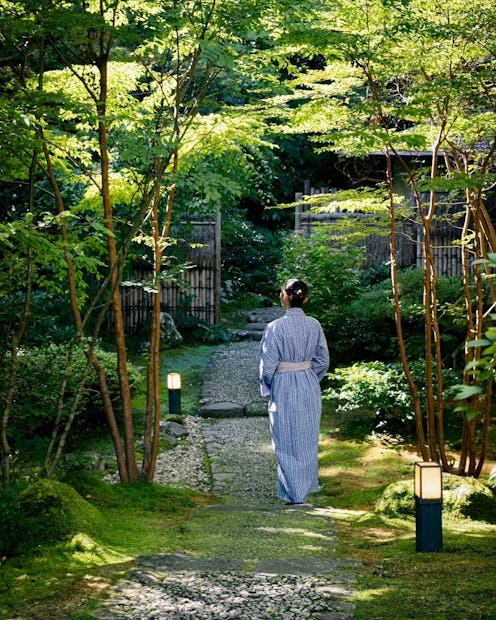(Travel)
This Tokyo Travel Guide Is All About Luxe & Exclusive Experiences
Yes, hot springs are included.

Home to a dazzling line-up of five-star hotels, unforgettable cultural attractions, and the most Michelin restaurants in the world (yes, even more than Paris itself), Tokyo has fascinated the most discerning luxury travelers for decades. Now, thanks in part to the weak yen and pent-up demand after more than two years of closed borders, the country is more accessible than ever before. (By far the most popular destination for young travelers, bookings to Japan in general have increased by 1,300% since 2019).
From staying in a hotel with views of Mount Fuji to soaking in a hot spring fit for royalty, here are some of the most extraordinary, one-of-a-kind things to do in and around Tokyo when price isn’t an object.
Get Lost In Translation
The most memorable character in Sofia Coppola’s beloved early aughts masterpiece Lost in Translation isn’t Scarlett Johansson’s aimless Charlotte or Bill Murray’s erring Bob — it’s the effortlessly cool hotel where the majority of the movie’s action takes place. At the real-life Park Hyatt Tokyo, guests can swim laps in a 26 x 65 foot pool surrounded by panoramic views of Tokyo’s skyline, sip pitch-perfect martinis in the 52nd floor’s sultry New York Bar, and peek at a snow-peaked Mount Fuji while savoring a full Japanese breakfast. In a city brimming with luxury properties, Park Hyatt Tokyo continues to feel literally and symbolically above the rest.
Eat Record-Setting Seafood
Tokyo is known for its iconic Toyosu fish market, where you can eat fresh sushi, watch fishmongers hard at work, and even see record-setting sales — in 2023, one bluefin tuna fetched ¥36.04 million ($273,000). While attending a tuna auction simply requires waking up very, very early, eating the prized catch calls for more planning. Your best bet: Book a month ahead at two-Michelin star Narisawa, a stalwart on Asia’s 50 Best Restaurants List. Chef Yoshihiro Narisawa has a close relationship with “Last King of Tuna” Yukitaka Yamaguchi, who frequently bids top dollar on the day’s top cuts. Alongside the exceptional fish, enjoy a decadent, omakase menu of grilled eel, wagyu, and other local delicacies.
Soak Up Japan’s Culture
For many, soaking in the healing waters of an onsen — a type of hot spring that must contain at least one of Japan’s 19 official mineral elements, such as sulfur and sodium chloride — is the epitome of zen. To immerse yourself in this ancient custom, Adrian Fautt, Park Hyatt Tokyo’s Chief Concierge, recommends checking into a ryokan, a traditional Japanese inn, overnight. (Most natural springs are located outside cities — fortunately, Hakone, a town known for its hot springs, is about an hour away by train).
Fautt’s pick is the elegant Gora Kadan, located on the grounds of the former summer villa of a member of the Imperial family. “It's right at the top of the mountains,” he says. “I would leave Tokyo in the early morning, spend half the day exploring the town of Hakone, and come back to the ryokan in the afternoon to enjoy the onsen before an elaborate dinner. When you wake up in the morning, you’ll be able to go to the onsen one more time before you check out.”
Try A Cocktail Tasting Menu
You’ve certainly heard of tasting menus at restaurants — but what about at cocktail bars? At Gen Yamamoto, master mixologist Yamamoto creates a mind-bending menu of low-ABV drinks. Served omakase-style, a Japanese phrase that literally means “I leave it up to you,” the only thing that customers have to decide is how many cocktails they want. (Trust me, you need all seven offered in a seating). Yamamoto thoughtfully selects fine liquors from around the world to showcase seasonal produce in surprising flavor combinations, like coffee and anise-flavored Coretto from Croatia’s Monachus Distillery balanced with lip-puckering grape juice. It’s more than worth the price of admission to witness an artist at work, shaking and stirring each of his 250-plus recipes from memory.
Do Some Local Luxury Shopping
If you’d like to come home with a one-of-a-kind, only-in-Japan souvenir, don’t expect to find it while browsing the glitzy, international boutiques of Ginza or Omotesandō. Instead, head to Nihonbashi, where you’ll discover both historic and modern shops, says Yukari Sakamoto, author of Food Sake Tokyo. “The historic Nihonbashi district has Japan's first department store, Mitsukoshi Nihonbashi, that originated as a kimono fabric shop 350 years ago,” she says.
The lively neighborhood is also full of the city’s best specialty food stores. “Check out pristine fruit in wooden boxes, such as juicy muskmelons, that can go for hundreds of dollars at Sembikiya. The café at Sembikiya offers tempting parfaits of seasonal fresh fruit and ice cream. Pick up titanium wine coolers that will keep bottles of white wine chilled without ice at SUS Gallery.” For an intimate and informative experience, book one of Sakamoto’s private guided field trips. A sommelier, chef, and shōchū advisor, she’s helped everyone from Phil Rosenthal (of Netflix’s Somebody Feed Phil) to chef Rick Bayless navigate Tokyo’s supermarkets and depachika (department store food basements).
Have Tea For Two
While some private tours, such as sumo stable visits, have yet to fully return post-COVID, new ones are cropping up — especially those that embrace the outdoors. That’s the case at Miyanoen, a historic tea farm located in one of Japan’s most famous tea regions less than an hour outside the city. “It’s very unusual that you can experience tea picking here in Tokyo — it’s something you don’t expect to see,” says Fautt. “The tea master, Keiji Miyano, has been on television several times now. You actually get to roast the tea leaves that you pick, and can even eat some as tempura.” The eight-hour excursion also includes hand-making matcha, wearing a chatsumi kimono (tea picking kimono), and drinking your own tea.
This article was originally published on